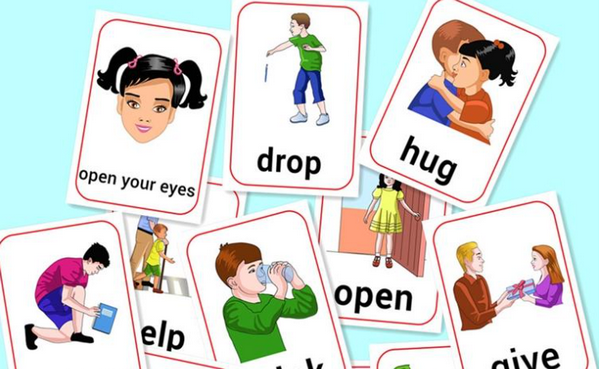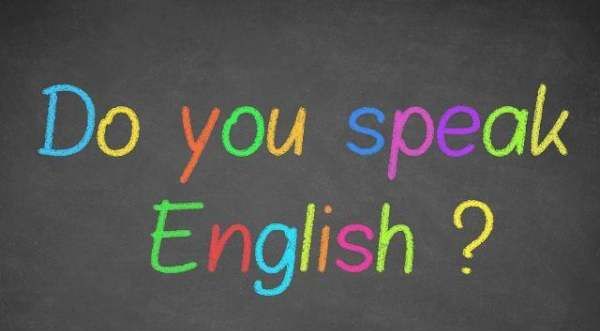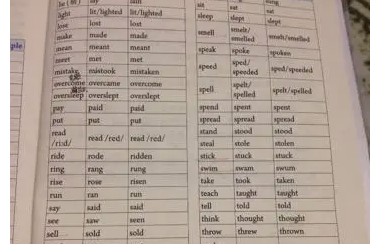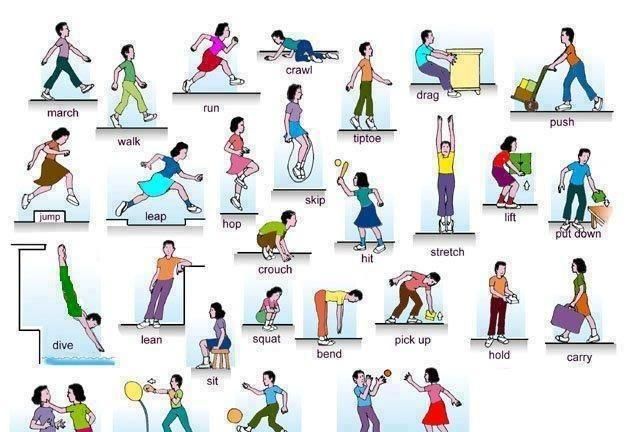本文目录
行为动词有哪些
行为动词有很多,如:go,come,surrender,kill,save,waste,find,lose,see,watch,get,reach,walk,run,swim,play,sleep,explore,advance,pull,drag,study,surf,start,miss,thank,like,cry等。
行为动词一般指实意动词,是表示动作的动词。

扩展资料
英语中的行为动词用法:
1、有的动词在英语里只能用作不及物动词,而汉语则可用作及物动词,如arrive到达,agree同意,listen听。英语里这些动词后面常接介词。如:
We arrived at the railway station at noon.
我们于中午到达火车站。(at不能省去)
(比较:We reached the railway station at noon.)
2、有的动词在英语里能用作及物动词,而在汉语里则不能用作及物动词,如serve为…服务。
Our children are taught to serve the people wholeheartedly.
我们的儿童被教以全心全意为人民服务。
除了be动词(am /is /are +not)以外的动词就是行为动词,当然包括他们各自的时态变形.
谓语动词若为行为动词,在其前加don't,如主语为第三人称单数,则用doesn't,同时还原行为动词。
小学英语中的动词都有哪些单词
一、什么是动词
动词(Verb)一般就是用来表示动作或状态的词汇。在英语中,动词按作用和功能主要分为两大类,一类是谓语动词,另一类是非谓语动词。
动词的意义:动词时表示动作或者状态的词。
 小学英语语法
小学英语语法
二、动词的分类
1. 实义动词
(1) 又称行为动词,能够独立作谓语。
We love animals very much.
The sun sets in the west.
(2) 分为及物动词和不及物动词,及物动词之后可以直接接宾语,而不及物动词后不可接宾语。
I like reading books very much.
The sun goes up.
2. 连系动词
即为系动词,不能够单独作谓语,必须和名词、形容词等一起使用作句子的谓语。
(1)表状态的连系动词: be, look, smell, sound, feel, keep
I don’t feel well today.
The garden looks very beautiful.
(2)表转换或结果的连系动词: become, get, grow, turn, go ,come,
The song sounds beautiful.
The weather is becoming warmer and warmer.
3. 助动词
是帮助实义动词完成某些语法功能的动词。助动词本身没有实义,不能单独作谓语,主要有be, do, have(has,had).
I am a worker.
Do you have a sister?
助动词的特征及用法

4. 情态动词
表示说话人对某一动作或者状态的态度。情态动词词义不完全,不能够单独作谓语,只能与动词原形一起构成谓语。小学阶段常见情态动词有can,must, need, will, may, could.
Can you swim across the river?
I must go to school be 7 o’clock or I’ll be late.
动词的几种基本形式
1. 动词原形:无变化
2. 第三人称单数现在时(与第三人称单数的形式构成和名词复数构成法相似)

3. 过去式和过去分词
规则变化

4.不规则变化
现在分词

英语动词大全
英语动词有sell卖、buy买、beat击打、look看、dance跳舞、sing唱歌、speak说、ride骑、ask问、answer回答、write写、tap拍、walk走、run跑、read读、study学习、fly飞、watch观察等。

英语动词可以分四类
英语动词分为:实义动词、系动词、助动词、情态动词。
说明:有些情况下,有些动词是兼类词,例如:
We are having a meeting.我们正在开会。(having是实义动词。)
He has gone to New York.他已去纽约。(has是助动词。)
小学英语动词大全1000个词
学习用品
pen pencil pencil-case ruler book bag comic book post card newspaper schoolbag eraser crayon sharpener story-book notebook magazine
人体
foot head face hair nose mouth eye ear arm finger leg tail
动物
cat dog pig duck rabbit horse elephant ant kangaroo monkey fish bird panda bear lion tiger sheep goat cow donkey
人物
friend boy girl mother father sister brother uncle man woman Mr Miss lady mom mother dad father parents grandparents grandpa grandma aunt cousin son classmate principal university student pen pal pal people
五,职业
teacher student doctor nurse driver farmer singer writer actor actress artist TV reporter engineer accountant policeman salesperson cleaner baseball player assistant policeman
颜色
red blue yellow green white black pink purple orange brown]
食品
rice bread beef milk water egg fish tofu cake hot dog hamburger noodles meat chicken pork mutton vegetable soup ice-cream Coke juice tea coffee (breakfast lunch dinner)
水果,蔬菜
apple banana pear orange watermelon grape eggplant green beans tomato potato peach cucumber strawberry onion carrot cabbage
衣服
jacket shirt T-shirt skirt dress jeans pants socks shoes sweater coat shorts sneakers slippers sandals boots hat
交通工具
bike bus train boat ship car taxi yacht taxi jeep van plane subway motor cycle
十一,杂物
window door desk chair computer board fan light teacher's desk picture wall floor curtain trash bin closet mirror end table football present lamp phone sofa shelf fridge table air-conditioner photo plate knife fork spoon ball kite box violin e-card e-mail traffic light money medicine
十二,地点
home room bedroom bathroom living room kitchen classroom school park library post office hospital cinema bookstore farm zoo garden study playground canteen teacher's office gym washroom art room company factory fruit stand pet shop nature park theme park bank village city
十三,国家
China/PRC America/USA England Canada/CAN
十四,天气
cold warm cool snowy sunny hot rainy windy cloudy weather reporter
十五,景物
river lake stream forest path raod house bridge building rain cloud sun mountain sky
十六,植物
flower grass tree seed sprout plant leaf
十七,星期
day Monday Tuesday Wednesday Thursday Friday Saturday Sunday weekend
十八,月份
month January February March April May June July August September October November December year
十九,季节
spring summer fall(autumn) winter
二十,方位
south north east west left right
二十一,患病
have a fever hurt have a cold have toothache have a headache have a sore throat
二十二,数词
One two three four five six seven eight nine ten eleven twelve thirteen fourteen fifteen sixteen seventeen eighteen nineteen twenty thirty forty fifty sixty seventy eighty ninety first second third fourth fifth eighth ninth twelfth twentieth
二十三,形容词
big small long tall short young old strong thin active quiet nice kind strict smart funny tasty sweet salty sour fresh favourite clean tired excited angry happy bored sad fine great heavy new fat happy right little lovely beautiful colourful pretty cheap expensive sick better
二十四,介词
in on under near behind next to over in front to from to for
二十五,代词
I me my we us our you your he him his she her it its they them their
二十六,动词
Play swim skate fly jump walk run climb fight swing eat like have turn buy take live teach go study learn sing dance row do homework watch TV read books cook the meals water the flowers sweep the floor clean the bedroom make the bed set the table wash the clothes do the dishes use a computer do morning exercises eat breakfast eat dinner go to school have English class play sports get up climb mountains go shopping play the piano visit grandparents go hiking fly kites make a snowman plant trees draw pictures cook dinner read a book answer the phone listen to music clean the room write a letter write an e-mail drink water take pictures watch insects pick up leaves do an experiment catch butterflies count insects collect insect collect leaves write a report play chess have a picnic get to ride a bike play the violin make kites collect stamps meet welcome thank work look help pass show use clean open close stop wait drive send feel become think wear put on go home go to bed play computer games do housework empty the trash put away the clothes get off(on) take a trip go on a trip read a magazine go to the cinema
二十七,疑问词
what(什么) what colour(什么颜色) what time(几点)
what day(星期几) how(怎样)how old(年龄多大,几岁)
how many(多少) how much (多少钱) how tall (多高)
how heavy(多重) how long(多长) how big(多大) how large(面积多大) who(谁) when(什么时候)
whose (谁的) where(在哪里) why(为什么)
which(哪一个)
二十八,be动词am is are was were二十九,助动词:do does did
三十,情态动词
can should would will

以上就是关于小学英语行为动词大全30个 ,行为动词有哪些的全部内容,以及小学英语行为动词大全30个 的相关内容,希望能够帮到您。
